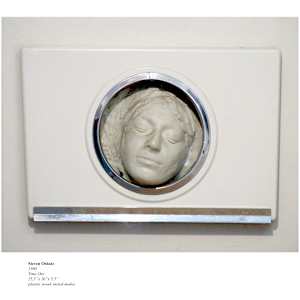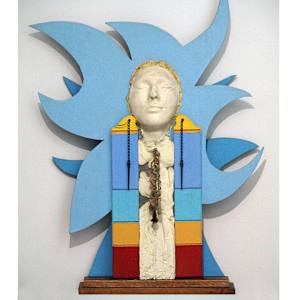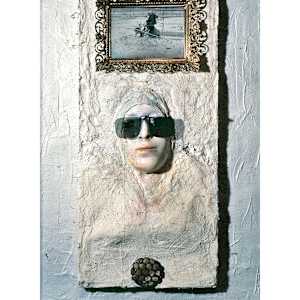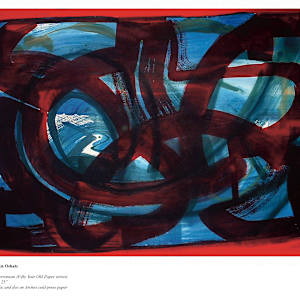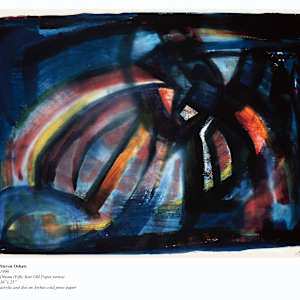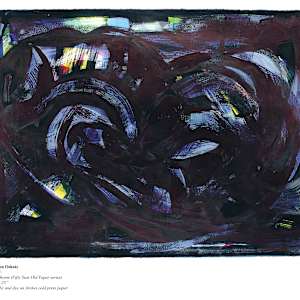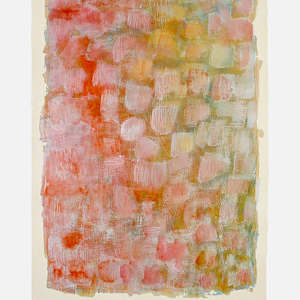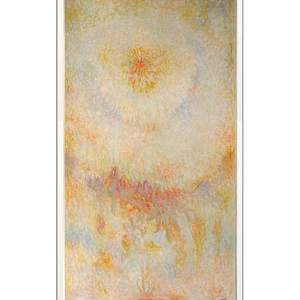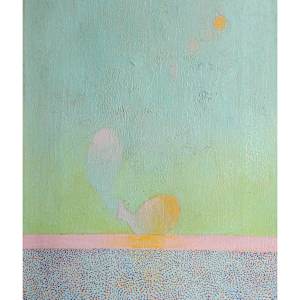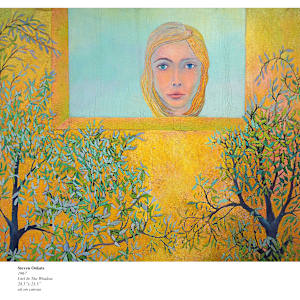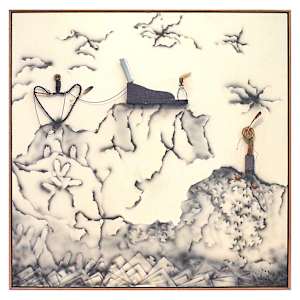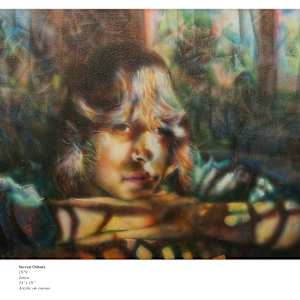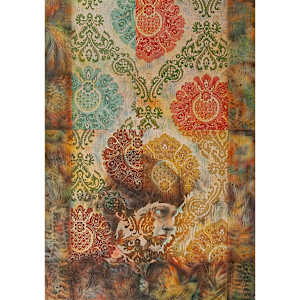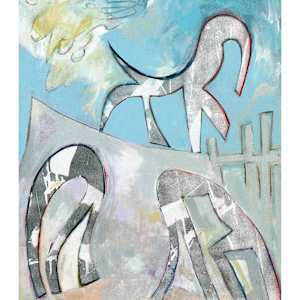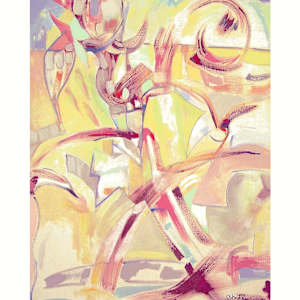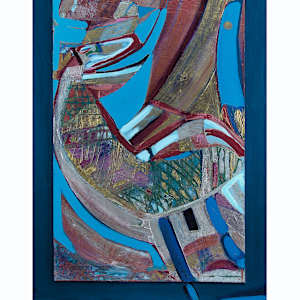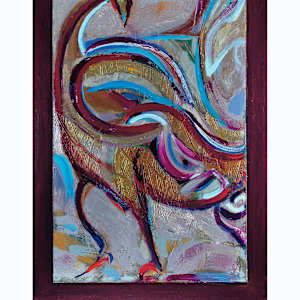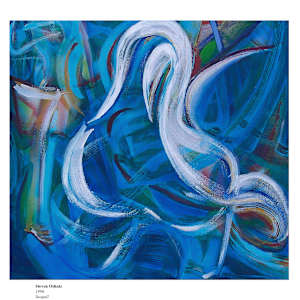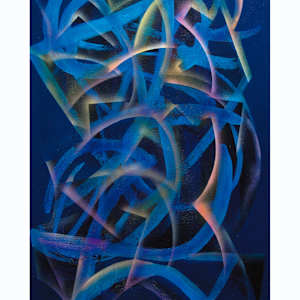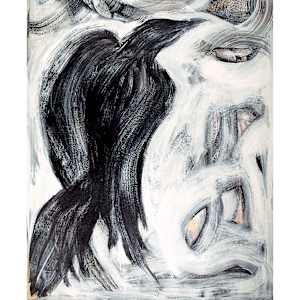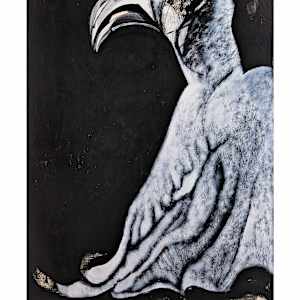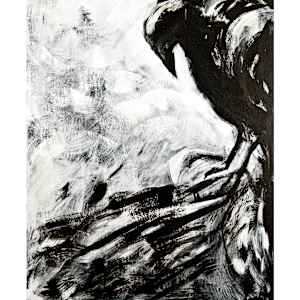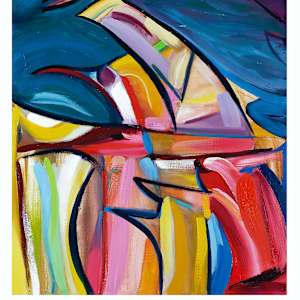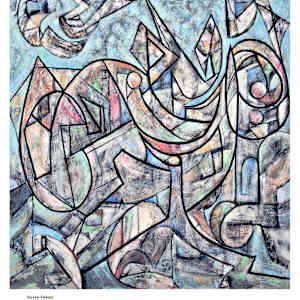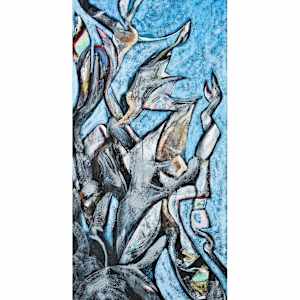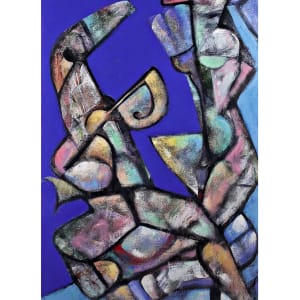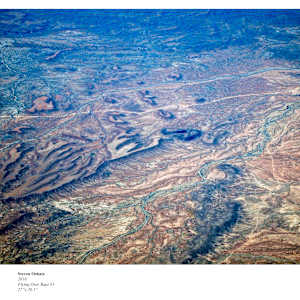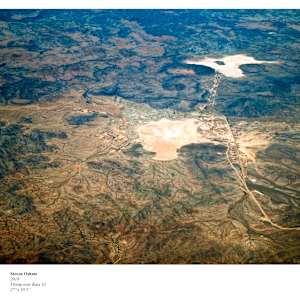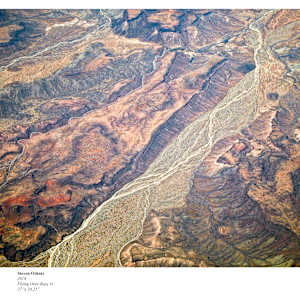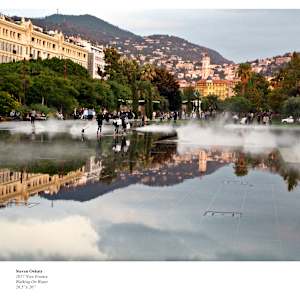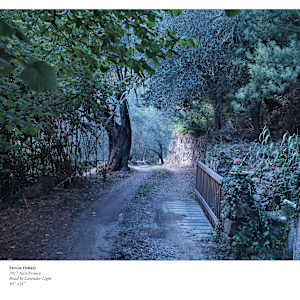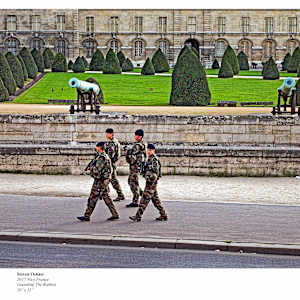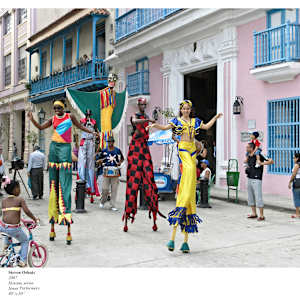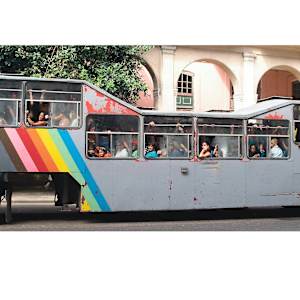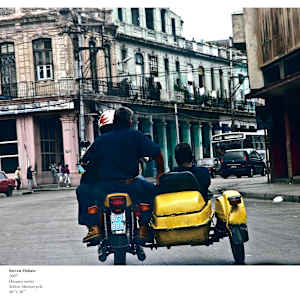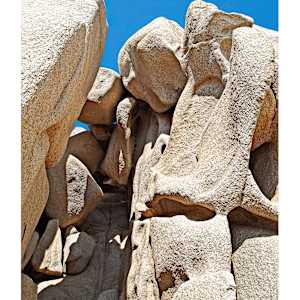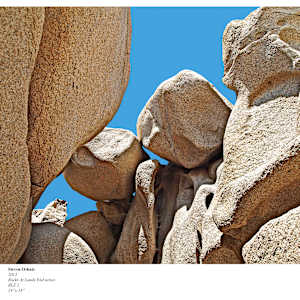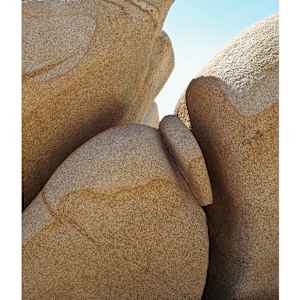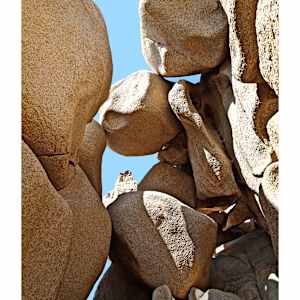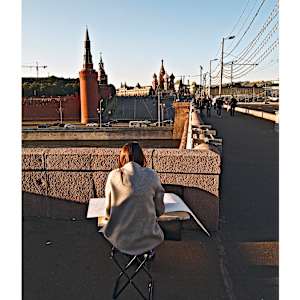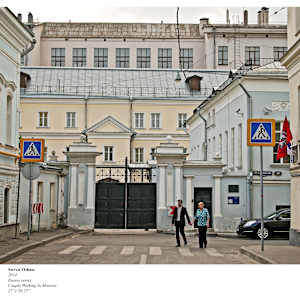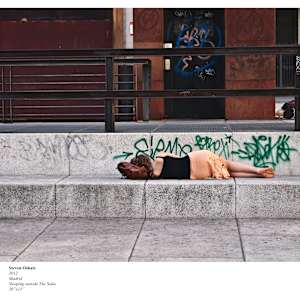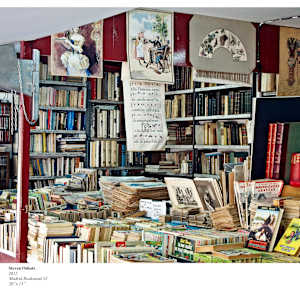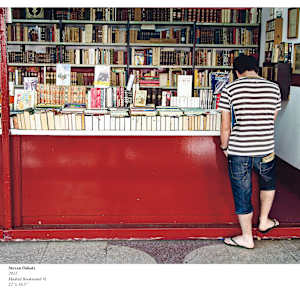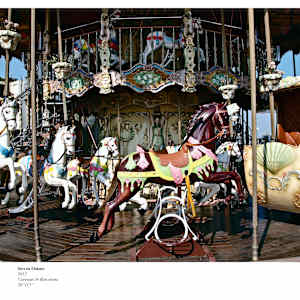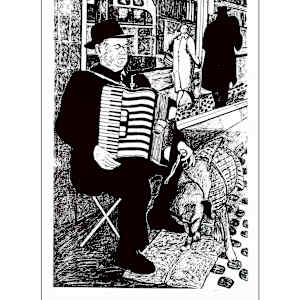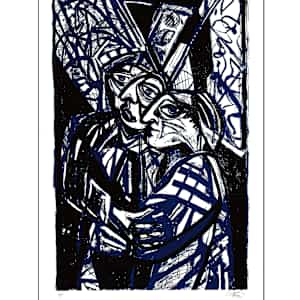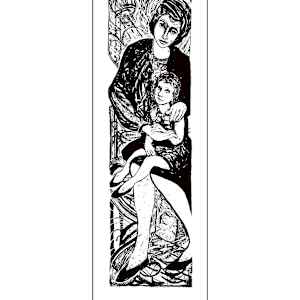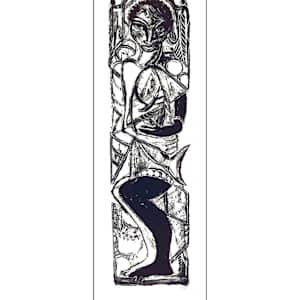FIFTY YEAR OLD PAPER SERIES
The Arches paper used for this art series was cold-pressed in the 1940s. Each painting floats on a 41"x29" linen background, framed in polished cherry wood.
MEN IN THE PARK
"I was attending art school in 1959, under the spell of a great teacher and artist Mr. Jepson. Everybody admired Jepson, we all talked like him, we all drew like him. I knew I had to find my own markings, my own lines. So, at lunch break I would take my drawing box and paper, a bag with my lunch and a collection of popsicle sticks to the park. McArthur Park, or Westlake Park as it was once known, is near downtown Los Angeles. The center of it is a lake, just the right size to stroll around or rent a boat and drift along with the swans and ducks. With my box and lunch,
I would walk around the lake, past the men and women feeding pigeons, to a grove of palm trees. Under the trees sat rows of picnic tables with men of all ages, shapes and color playing checkers, chess, cards and dominoes; talking, yelling, laughing, spending their time together in the park. I would find a place to sit, eat my lunch, the whittle a point on a popsicle stick, dip it in ink and begin drawing.
I dropped out of art school in the beginning of summer 1960, and rented a studio in an old building at the east end of Hollywood Boulevard. My studio was on the second floor, which also housed three other studios, one of which was rented by a young actor, Dennis Hopper. Dennis was better known for his photography than acting back then. He had rented the studio because he had begun experimenting with painting. Dennis was a protege of the painter Emerson Wolfer, and I had been a student of Wolfer. I had started a painting based on one of the drawings from "Men In The Park". At the time I was obsessed with Cezanne. Reproductions of his paintings covered my walls. Dennis was discovering Jackson Pollack. He had a canvas stretched on the floor and paint pots with paint dripping over sticks. Color swirled over the cans respecting no edge, merging onto the floor, into a trail of footprints leading out his door, one path to the bathroom, the other to my studio door where he would call to me, "Hey man, will you come take a look?" I went over to his studio and he asked me what I thought. I looked and said something like "I think Jackson has already gone there, Dennis." He looked at me with a hurt look and then stomped over to my studio, look at the painting I was laboring on and remark "Man, I think you are in the wrong century!"
I would walk around the lake, past the men and women feeding pigeons, to a grove of palm trees. Under the trees sat rows of picnic tables with men of all ages, shapes and color playing checkers, chess, cards and dominoes; talking, yelling, laughing, spending their time together in the park. I would find a place to sit, eat my lunch, the whittle a point on a popsicle stick, dip it in ink and begin drawing.
I dropped out of art school in the beginning of summer 1960, and rented a studio in an old building at the east end of Hollywood Boulevard. My studio was on the second floor, which also housed three other studios, one of which was rented by a young actor, Dennis Hopper. Dennis was better known for his photography than acting back then. He had rented the studio because he had begun experimenting with painting. Dennis was a protege of the painter Emerson Wolfer, and I had been a student of Wolfer. I had started a painting based on one of the drawings from "Men In The Park". At the time I was obsessed with Cezanne. Reproductions of his paintings covered my walls. Dennis was discovering Jackson Pollack. He had a canvas stretched on the floor and paint pots with paint dripping over sticks. Color swirled over the cans respecting no edge, merging onto the floor, into a trail of footprints leading out his door, one path to the bathroom, the other to my studio door where he would call to me, "Hey man, will you come take a look?" I went over to his studio and he asked me what I thought. I looked and said something like "I think Jackson has already gone there, Dennis." He looked at me with a hurt look and then stomped over to my studio, look at the painting I was laboring on and remark "Man, I think you are in the wrong century!"
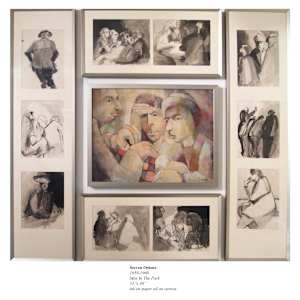
PHOTOGRAPHS: HAVANA SERIES
"Those who have had the good fortune to visit Havana, know the compulsion of wanting to photograph EVERYTHING. Such is the pull of this place that exists just beyond our reach.
We spent a week driving and walking through the neighborhoods of the city. I had set my camera in automatic mode, shooting a large jpeg file, so that I could be spontaneous. A tripod would have inhibited our flow with the experience. I was basically taking snapshots. By the end of our stay I had taken close to a thousand pictures.
There is a term in Korean landscape painting called “True Painting”. The landscape becomes a map of the artist’s journey. People look at photo albums in a similar way; the images stimulate our memories. Our hostess was very generous in offering to drive us around, introducing us to the various neighborhoods and nuances of the complex labyrinth that is Havana. Sitting in the back seat of our hostess’ car, snapping the camera’s shutter, I became aware of the gesture of the moment; the out of focus blur created by this animated process of viewing the city. During much of the 20th. and now the 21st. Century, our experience of the landscape of the world around us has been textured by this animation.
In January 1959, Castro's victorious army rolled into Havana. I was at an art school in Los Angeles and remember the headlines in the newspapers, and how excited we all were about the changing world. The Cuban revolution was a part of our social landscape.
Though the architecture of Havana is haunting, and its iconic automobiles a link to our connective past; one becomes aware that the real heart and soul of Havana lies in the vibrance of its inhabitants. It’s people are a magnet to our eye. Whether in a moving car or from the intimate perspective of walking the winding alleys and cobblestones of Habana veija, old Havana; I pointed my camera at anything and anyone that caught my eye.
When I returned to my studio, I started viewing the pictures and became aware of the layered stories of place and time. They began to create a rhythm in my mind, a twisting path of histories leading to the present. I felt the need to take them out of their virtual world and translate them into prints - large prints. As I made my selection of images and then hung the 30” x 40” proofs around my studio, a new presence emerged. Collectively they became a portrait of a city and its people."
We spent a week driving and walking through the neighborhoods of the city. I had set my camera in automatic mode, shooting a large jpeg file, so that I could be spontaneous. A tripod would have inhibited our flow with the experience. I was basically taking snapshots. By the end of our stay I had taken close to a thousand pictures.
There is a term in Korean landscape painting called “True Painting”. The landscape becomes a map of the artist’s journey. People look at photo albums in a similar way; the images stimulate our memories. Our hostess was very generous in offering to drive us around, introducing us to the various neighborhoods and nuances of the complex labyrinth that is Havana. Sitting in the back seat of our hostess’ car, snapping the camera’s shutter, I became aware of the gesture of the moment; the out of focus blur created by this animated process of viewing the city. During much of the 20th. and now the 21st. Century, our experience of the landscape of the world around us has been textured by this animation.
In January 1959, Castro's victorious army rolled into Havana. I was at an art school in Los Angeles and remember the headlines in the newspapers, and how excited we all were about the changing world. The Cuban revolution was a part of our social landscape.
Though the architecture of Havana is haunting, and its iconic automobiles a link to our connective past; one becomes aware that the real heart and soul of Havana lies in the vibrance of its inhabitants. It’s people are a magnet to our eye. Whether in a moving car or from the intimate perspective of walking the winding alleys and cobblestones of Habana veija, old Havana; I pointed my camera at anything and anyone that caught my eye.
When I returned to my studio, I started viewing the pictures and became aware of the layered stories of place and time. They began to create a rhythm in my mind, a twisting path of histories leading to the present. I felt the need to take them out of their virtual world and translate them into prints - large prints. As I made my selection of images and then hung the 30” x 40” proofs around my studio, a new presence emerged. Collectively they became a portrait of a city and its people."


